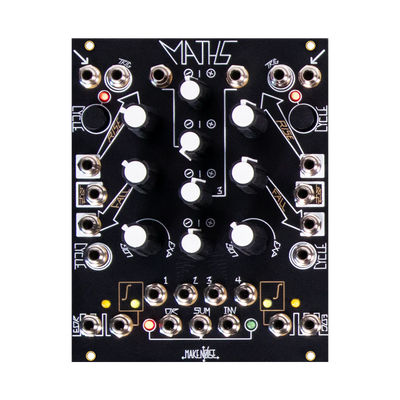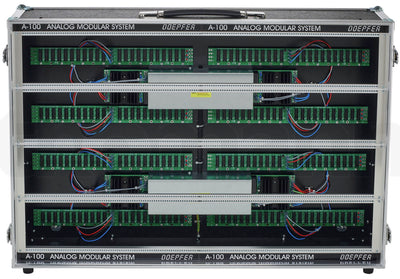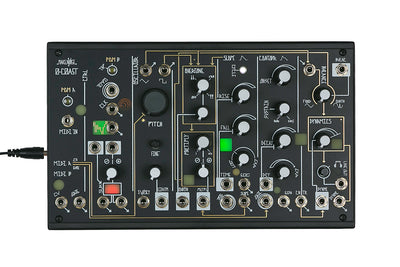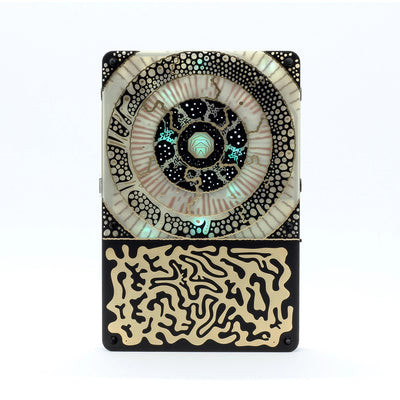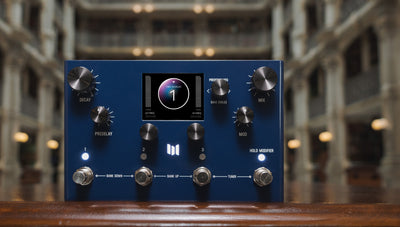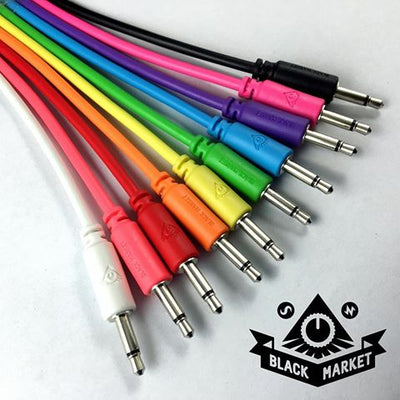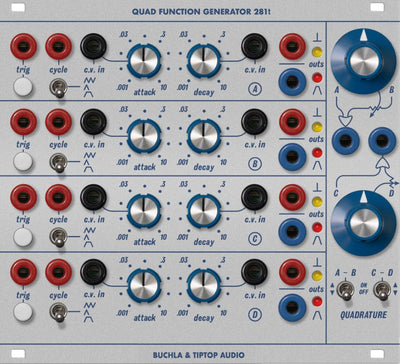Meet LinnStrument, an expressive MIDI controller for musical performance. Unlike the simple on/off switches of a standard MIDI keyboard, LinnStrument's backlit note pads sense each finger's subtle movements in five ways, enabling musical performance expression rivaling that of fine acoustic instruments.
LinnStrument's patented touch-sensing technology permits you to slide in pitch directly from one note to another, tilt your finger forward/backward for subtle timbral variation, or vary note loudness with pressure or velocity, all sensitive to very light touches.
The piano's note arrangement works well for piano music, but its uneven pitch intervals and rear-positioned black keys make it ill-suited for performing natural pitch bends and slides, an important element of expressive performance.
Stringed instruments don't have this problem because the semitones are uniformly spaced.
So LinnStrument's notes are arranged as on any stringed instrument. Each row is a series of consecutive semitones, so bends and pitch slides are simple and intuitive: play a note, slide left or right to the destination note, then wiggle it for vibrato.
You can tune the rows like a guitar, violin or however you wish. By default they are tuned in musical fourths (five semitones), like a bass guitar with 8 strings. This note arrangement is called the 4ths String Layout and is fast becoming a new standard for expressive musical control, used in Ableton Push, Roli's LightPad Block, a variety of iPad apps and now over 1900 LinnStruments sold.
To make it easy to find the right notes, the scale notes are lit, with all the C note pads lit in a different color and having a Braille-size bump for tactile feedback. Alternatively, you can light any scale and in any of 10 colors.
LinnStrument sends standard MIDI messages over its USB or MIDI output jacks, and is configured by default to work out-of-the-box over a single MIDI channel for compatibility with every MIDI sound generator in existence, but with the advantages over a MIDI keyboard of performed vibrato, note-to-note pitch slides, polyphonic pressure sensing, and forward/backward touch control. And LinnStrument gets around MIDI's one-channel Pitch Bend limitations by automatically quantizing polyphonic pitch slides to semitones, while leaving solo pitch slides continuous.
Works with every MIDI synth. MPE-compatible
To also perform fully polyphonic pitch slides and Y-axis gestures, you'll need a synth that's compatible with MPE (MIDI Polyphonic Expression), a new MIDI standard that uses a separate MIDI channel for each touch. It's already supported in a long list of major software instruments. We even include free sounds files for Apple's MainStage and Logic, plus a free license for Bitwig 8-Track, all of which support MPE in their built-in synths.
Extraordinarily Versatile
Step Sequencer - Use LinnStrument's RGB note pads as a powerful 2-track step sequencer with per-note velocity/duration/bend/y-axis values, any time signature, independent track step sizes and loop lengths, scales/drums/notes views, reverse play, live play while sequence plays, swing timing and more.
Expressive Swing Arpeggiator - LinnStrument's built-in Arpeggiator responds to all dimensions of movement for entirely new ways of beat-synced play. The Replay All mode creates chordal rhythms merely by varying chord pressure, and makes LinnStrument the world's only MPE beatbox.
Split Keyboard / Strum / CC Faders- You can split the keyboard to play two different sounds, and adjust the split point as you like. You can use one split to strum notes fingered on the other split as like a guitar. Or use either split as eight horizontal Control Change Faders to adjust 8 sound parameters in real time as you play.
Low Row - The lowest row of note pads can be reassigned to act as a Sustain Pedal, a Modulation or Bend strip, to momentarily enable the Arpeggiator (sliding your thumb to vary its rate), to restrike a fingered chord, or even as a 3D control strip, modulating three parameters at once.
Play on a table or standing - you can play it on a table like a keyboard, but at only 5 pounds (large model) and 1" thin, you can also use the included guitar strap pins to play it standing up like a guitar.
Single or Dual Foot Switch Input - Connect a standard single or dual foot switch for foot control of sustain, Arpeggiator, octaves, Tap Tempo, Control Change messages and more.
All Settings on front panel / Open Source software - All of LinnStrument's settings are available on the front panel so there's no need to fumble with computer editing software. And even with all of LinnStrument's versatility, we didn't want to limit how people would use it. So we released the software as open source, allowing you to customize everything.
LinnStrument Specifications
General
• Dimensions:
LinnStrument: 22.4" (570 mm) x 8.22" (209 mm) x 1" (25.4 mm)
LinnStrument 128: 15.7" (399 mm) x 8.22" (209 mm) x 1" (25.4 mm)
• Steel top panel, aluminum chassis, cherry wood side pieces
• Weight:
LinnStrument: 5 pounds
LinnStrument 128: 4 pounds
• Inputs/Outputs:
> USB Type B jack (for data and bus power)
> MIDI Input and MIDI Output jack
> Foot Switch jack: 1/4" TRS, for dual or single foot switch, normally-closed or normally-open
> (LinnStrument only) Power Input jack: 7.5 to 12 volts, AC, DC center-positive or center-negative, at least 300 mA
• Power requirements:
LinnStrument:
> USB: current draw of 275 mA (or 225 mA in Low Power mode) with default lights and Split mode on.
> Power input: 7.5 to 12 volts; DC center-positive, DC center-negative or AC; current draw of 275 mA (or 225 mA in Low Power mode) with default lights and Split mode on.
LinnStrument 128:
> USB only: current draw of 250 mA (or 200 mA in Low Power mode) with default lights and Split mode on.
What's in the box
• Soft padded and zippered travel case. LinnStrument 128's case is a zippeed neoprene sleeve case, similar to a notebook sleeve.
• 4 guitar strap buttons and 4 metric M4 screws for attachment to corners of LinnStrument or LinnStrument 128.
• 10 foot black USB cable.
• A letter of introduction, personally signed by Roger.
Note:
1) A power supply (for LinnStrument) is not included. Why? Because LinnStrument is nearly always USB bus-powered, even from any Lightning iPad or iPhone, and when using the MIDI jacks any USB power adaptor can be used. For those rare cases where a power supply might be preferred, we sell a power supply separately. Or any power supply can be used that has a standard 5.5mm outside diameter / 2.1mm inside diameter round connector, 7.5 to 12 volts, either AC, DC center-positive or DC center-negative, and at least 300 milliamperes of current.
2) A printed manual is not included. The manual and all documentation are on our web site so that they are always fully up to date.
3) Computer driver software is not included because LinnStrument MIDI-over-USB is fully USB Class Complaint, using the standard Mac, Windows or Linux drivers.
4) A computer editing application is not included because all settings can be accessed on the front panel.
Sensor
• Playing Surface:
> Size of playing area:
> LinnStrument: 476 mm (18.75") x 153 mm (6"), 200 note pads (25 columns by 8 rows)
> LinnStrument 128: 305 mm (12") x 153 mm (6"), 128 note pads (16 columns by 8 rows)
> Translucent silicone rubber is 2mm thick, 50% compressible when pressed.
> Each note pad is 17 mm square, spaced 19mm center-to-center, with 2 mm wide, .5 mm deep recessed channels between note pads.
> In the center of each "C" note (in the default 4ths tuning and no transposition) is a small Braille-size bump for tactile feedback in finding the correct notes to play.
• Pitch Range (with default 4ths tuning and no transposition):
LinnStrument: 5 octaves (60 notes, F#0 to F5)
LinnStrument 128: 4 octaves+ (51 notes, F#0 to G#4)
• Sensing Capability:
> Velocity, release velocity, continuous pressure, continuous X-axis (left-right) movement and continuous Y-axis (forward-backward) movement, independently and simultaneously for all touches.
> Sliding a touch left or right across multiple note pads results in a continuous pitch change to the originally-pressed note.
• Sensor Limitations:
> Only one touch is permitted within each note pad.
> If 3 note pads are pressed that are 3 corners of a rectangle, presses to a note pad that is the 4th corner of that rectangle will be ignored.
> No more than 3 note pads are permitted in the same vertical column. Pressing a 4th note pad in the same column will be ignored.
> Y-axis (forward-backward) movement is limited to the 17 mm vertical dimension of each note pad. Sliding your finger vertically across rows will result in a new note when the touch enters the next vertical note pad.
> Maximum simultaneous touches: about 50.
> Minimum distance between any 2 touches: 5 mm, but the 2 touches must be in 2 adjacent note pads.
• Touch Sensitivity:
> Minimum touch force is approximately 70 grams.
> Touch force to produce higher pressure value: approximately 700 grams.
> High, medium and low sensitivity settings for both Pressure and Velocity
• Latency:
> Typical latency from striking a note pad to reception of a USB MIDI message at the computer (or DIN MIDI message at receiving MIDI device) is 2 mS.
MIDI
• MIDI messages sent:
> Note On with velocity
> Note Off with release velocity
> Pressure sent as either Channel Pressure, Poly Pressure or CC 0-127.
> X-axis (left-right) movements sent as Pitch Bend, including pitch slides across multiple note pads
> Y-axis (forward-backward) movements sent as CC 0-127, Channel Pressure or Poly Pressure.
•MIDI Modes:
> One Channel: All notes sent over a single MIDI channel.
> Channel Per Note: Each touch is sent over its own MIDI channel from user-defined range of channels.
> Channel Per Row: Each row's touches are sent over a separate MIDI channel
• MIDI Input accepts MIDI Clock (for arpeggiator sync), full NRPN control of all internal parameters, CC full control of all lights.
Lights
• LEDS: Each of the note pads and 8 control buttons has an independently-controlled RGB (red/green/blue) LED.
• Permitted colors: red, green, blue, cyan, magenta, yellow, white, orange, lime and pink
Special Features
• Polyphonic step sequencer
• Split Keyboard Mode with unique MIDI settings for each split
• Volume Button displays horizontal light bar on screen for easy volume adjustment
• Preset Button displays MIDI Program Change number on screen (1-128) for easy selection by sliding your finger across surface
• Two Programmable Panel Switches
• CC Faders Mode permits either split to act as 8 horizontal light bars to control CC 1-8
• Arpeggiator
• Strum Mode: "strumming" the rows of the right split plays any notes held in the left split.
• Low Row Mode: the lowest row may be used as a continuous MIDI control strip, sustain bar, arpeggiator on/off or other functions.
For details of all features and settings, see the User Manual.


